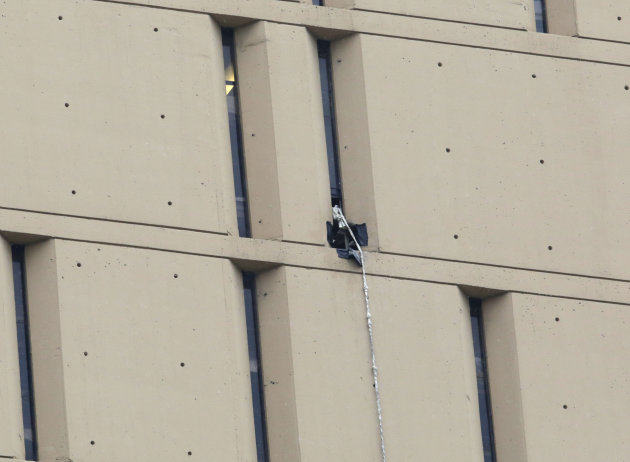Execs avoid laundering charges

When the
Justice Department announced its record $1.9 billion settlement against British bank
HSBC
last week, prosecutors called it a powerful blow to a dysfunctional
institution accused of laundering money for Iran, Libya and Mexico's
murderous
drug cartels.
But to some former federal prosecutors, it was only the latest case
of the government stopping short of bringing criminal money laundering
charges against a big bank or its executives, at least in part on the
rationale that such prosecutions could be devastating enough to cause
such banks to fail.
They say it sounds a lot like the "too big to fail" meme that kept
big but sickly banks alive on the support of taxpayer-funded bailouts.
In these cases, they call it, "Too big to jail."
"Shame on the Department of Justice. Shame on them," said Jimmy Gurulé, a former federal prosecutor who teaches law at the University of Notre Dame.
"These are actions that facilitated major international drug cartels to continue their operations," he said. "Now, if that doesn't justify criminal prosecution, I can't imagine a case that would."
Oregon Democratic Sen. Jeff Merkley shot off a letter to U.S. Attorney Eric Holder after the HSBC
settlement, saying the government "appears to have firmly set the
precedent that no bank, bank employee, or bank executive can be
prosecuted even for serious criminal actions if that bank is a large,
systemically important financial institution."
Neil Barofsky, the former
inspector general of the government's Troubled Asset Relief Program and a
former federal prosecutor in New York, warned that big banks could
interpret the Justice Department's leniency as "a license to steal."
Since 2009, several European banks have paid heavy settlements
related to allegations they moved money for people or companies on the
U.S. sanctions list: Switzerland's Credit Suisse, $536 million; British
bank Barclays, $298 million; British bank Lloyds, $350 million; Dutch
bank ING, $619 million; and the Royal Bank of Scotland, $500 million for
alleged money laundering at Dutch bank ABN Amro.
While those cases involved deals with such countries as Iran, Libya, Cuba and Sudan, the HSBC case was notable for the government's allegation that it also helped launder $881 million in drug-trafficking proceeds for Mexican drug cartels.
As bad as those allegations were, prosecutors say they could not prove HSBC
executives conspired to aid drug organizations or rogue nations.
Breakdowns in security controls within the company had occurred
gradually, over decades, with a motive of increasing profits rather than
committing crimes, prosecutors said.
Prosecutors also expressed fear of "collateral consequences" — that
going further could have sunk a company that employs tens of thousands
of people and is tied tightly to the economies of the roughly 80
countries where it does business.
Such a collapse has happened in white-collar prosecutions before,
most notably in 2002 when the huge accounting firm Arthur Andersen was
convicted for destroying Enron-related documents before the energy
giant's collapse. It was forced to surrender its accounting license and
to stop conducting public audits. Only after 85,000 people worldwide
lost their jobs did the court case ultimately play out, with the Supreme
Court overturning the conviction too late to save the doomed
Chicago-based business.
"From a policy standpoint, it's a pretty compelling argument," said
Kevin O'Brien, a former federal prosecutor now in private practice.
"Employees lose their jobs, towns where these businesses are located are
negatively affected, stockholders which include a lot of moms and pops
lose their savings and none of that is really fair. Even a large fine
can sometimes have a negative effect on employees and shareholders."
Bill Black, a former financial regulator who was instrumental in
uncloaking the savings-and-loan crisis in the 1980s, scoffed at such a
notion. "Seriously, you want to keep felons in charge of a bank for bank
stability?" he said.
To Black and other critics of the government's approach, the HSBC
case is a replay of the years immediately after the 2008 financial
crisis, when the people most responsible for it were never really
punished. No high-profile bankers have gone to jail in the wake of the
financial crisis, nor has there been any well-known, large-scale effort
to recover the giant bonuses awarded to executives of failed or nearly
failed banks.
In the HSBC
case, the bank has rescinded deferred compensation bonuses given to its
most senior executives and agreed to partially defer bonus compensation
for its most senior executives during the next five years.
"The guy who filed a false tax return, he's probably doing five years
in prison," said Notre Dame's Gurulé. "And these guys — transactions
with Iran, threatening to jeopardize U.S. national security — they don't
even get prosecuted. The fairness of that system is very suspect."
The government's charges against HSBC are grim. They sketch a picture of a bank that systemically and purposefully skirted the law.
HSBC
willfully failed to keep proper anti-laundering programs in place and
to conduct due diligence on its customers, the government says. Court
documents showed that the bank let over $200 trillion between 2006 and
2009 slip through relatively unmonitored, including more than $670
billion in wire transfers from HSBC Mexico, making it a favorite of drug cartels. At the same time, the bank gave Mexico its lowest risk rating for money laundering.
The cartels are a deadly force, controlling large swaths of Mexico
as virtual mafias. The government of former President Felipe Calderon
started reporting drug-related killings when it took office in late
2006, but stopped more than a year ago when the toll reached 47,500.
Many private groups now put the number close to 60,000.
In July, the Senate's Permanent Subcommittee on Investigations produced a damning 334-page report that told a similar story.
In one email cited in the Senate committee's report, an HSBC
executive pushed to reopen a part of the bank's business that had been
closed to a Saudi Arabian bank with possible links to the Sept. 11
attacks.
At a hearing with the committee in July, the bank's head of group compliance broke from his prepared testimony to resign.
Henry Pontell, a criminologist
who teaches at the University of California-Irvine, was underwhelmed by
the $1.9 billion in fines against HSBC, given its $17 billion in profits last year.
"The notion that 'Oh, they paid a
big fine, that will scare everyone else,' is nonsense," Pontell said.
"Those individuals that did this, they didn't pay the $1.9 billion. The
company did. And that's supposed to be an effective deterrent? A
white-collar criminal, the biggest thing they fear is being put into
prison."























 Jared
Diamond contrasts our modern methods of raising children with those
used in more traditional societies, such as the villagers of New Guinea.
Jared
Diamond contrasts our modern methods of raising children with those
used in more traditional societies, such as the villagers of New Guinea.


 The little monkey wearing a shearling coat
that showed up at a Toronto IKEA last week is now a case for the
courts. Toronto Animal Services lodged the monkey named Darwin at the
Story Brook Farm Primate Sanctuary. Yasmin Nakhuda, who owns the monkey,
wants him back.
The little monkey wearing a shearling coat
that showed up at a Toronto IKEA last week is now a case for the
courts. Toronto Animal Services lodged the monkey named Darwin at the
Story Brook Farm Primate Sanctuary. Yasmin Nakhuda, who owns the monkey,
wants him back.